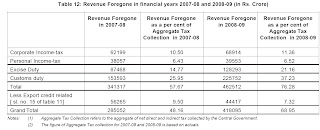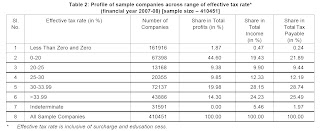Of the total tax assessed, both direct and indirect, 76.28% is estimated to be foregone in 2008-09. In other words, only less a rupee out of every four rupee of tax assessed is actually due for collection!
The 4,10,451 private firms which filed their income tax returns before the IT department reported Rs. 7,11,557 Cr as profits before taxes. However, they declared a total income (taxable income) of only Rs. 4,79,898 Cr only during 2007-08 (for filing in financial year 2008-09) and paid Rs. 1,58,225 crore as corporate tax during the same financial year. They also paid Rs. 6,533 crore as Fringe Benefit Tax and Rs. 10,670 crore as Dividend Distribution Tax during the year. The effective tax rate of the entire sample was 22.24%, which was substantially lower than the statutory tax rate of 33.99%. The revenue foregone for 2007-08 which was estimated last year to be Rs. 58,665 crore, has now been estimated at Rs. 62,199 crore for 2008-09.
It is a well established fact, both in theory and practice, that indirect tax cuts are mostly corenered by the producers and when they get transferred to consumers only a small share gets shared with them. In the circumstances, indirect taxes are a backdoor subsidy to businesses. Income foregone in 2007-08 on excise duty was Rs. 87,468 crore and on customs duty Rs. 1,53,593 crore, adding to a total of Rs. 3,03,260 crore. Even a very charitable 50% share of this is Rs 1.5 lakh Cr in give-aways.
A few interesing figures from the statement of revenues foregone
1. The share of revenues foregone as a share of tax aggregate ins showing a sharply increasing trend, jumping from 57.67% of aggregate tax collection in 2007-08 to 76.28% estimated for 2008-09, thanks in the main to the inderct tax give-aways, ostensibly to stimulate the economy. At a time when the fiscal deficit is widening, the economic conditions are weak, and now a drought (with all its fiscal requirements) staring us, it is surely a big concern that tehre are such large revenue leakages (or give-aways). And in any case, were we not supposed to progressively rationalize the tax system to cut down on such foregone revenues?

2. 67398 companies, which had 44.60% of the share in total corporate profits, were taxed at an effective rate in the range of 0-20%, and therefore formed just 21.89% in the total tax payabvle. Interestingly, therse were among the most profitable of private companies, since their 44.6% of profit share came from a mere 19.43% share in total corporate income.

3. In an inversion of the progressiveness (and fairness) principle of taxation, the effective tax rate decresed in invesrse proportion to the total profits. The smallest companies, those with profits less than Rs 10 Cr, had the largest effective tax rate.

P Sainath, in his irrepressible style, dripping with sarcasm, makes several interesting points about the tax give-aways. The Rs. 68,914 crore of revenues foregone from corporate revenues in 2008-09 dwarfs the Rs. 39,100 crore allocated for NREGS covering tens of millions of impoverished human beings. The punchline is devastating, "Ask for an expansion of the NREGS, seek universal access to the PDS, plead for more spending on public health and education — and there’s no money. Yet, there’s enough to give away nearly Rs. 30 crore an hour to the corporate world in concessions."
No comments:
Post a Comment